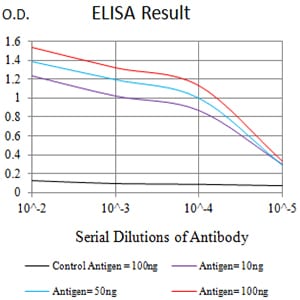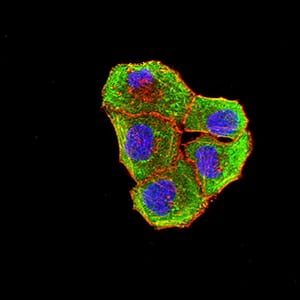

| WB | 咨询技术 | Human,Mouse,Rat |
| IF | 咨询技术 | Human,Mouse,Rat |
| IHC | 咨询技术 | Human,Mouse,Rat |
| ICC | 1/100 - 1/500 | Human,Mouse,Rat |
| FCM | 咨询技术 | Human,Mouse,Rat |
| Elisa | 1/10000 | Human,Mouse,Rat |
| Aliases | BTLA1; CD272 |
| Entrez GeneID | 151888 |
| clone | 7B8B4 |
| WB Predicted band size | 32.8kDa |
| Host/Isotype | Mouse IgG1 |
| Antibody Type | Primary antibody |
| Storage | Store at 4°C short term. Aliquot and store at -20°C long term. Avoid freeze/thaw cycles. |
| Species Reactivity | Human |
| Immunogen | Purified recombinant fragment of human BTLA (AA: extra 31-157) expressed in E. Coli. |
| Formulation | Purified antibody in PBS with 0.05% sodium azide |
+ +
以下是关于BTLA抗体的3篇代表性文献及其摘要概述:
1. **文献名称**:*"BTLA/HVEM Signaling: A New Target for Cancer Immunotherapy"*
**作者**:Gavrieli, M., Murphy, K.M.
**摘要**:该文献阐明了BTLA(B and T淋巴细胞衰减子)与其配体HVEM(疱疹病毒侵入介质)的相互作用机制,指出BTLA在抑制T细胞活性中的关键作用,并探讨了通过阻断BTLA信号通路增强抗肿瘤免疫反应的潜力。
2. **文献名称**:*"Anti-BTLA Antibody Enhances CD8+ T-cell Responses and Tumor Immunity"*
**作者**:Liechtenstein, T., et al.
**摘要**:研究通过动物模型证明,使用抗BTLA抗体可解除BTLA对T细胞的抑制作用,显著增强CD8+ T细胞介导的抗肿瘤免疫反应,并抑制肿瘤生长,提示其在癌症免疫治疗中的应用前景。
3. **文献名称**:*"Co-inhibitory Receptor BTLA Regulates T-cell Activation through Interaction with HVEM"*
**作者**:Sedy, J.R., et al.
**摘要**:该研究揭示了BTLA与HVEM结合的分子机制,发现BTLA通过抑制T细胞受体(TCR)信号通路调控免疫耐受,并与其他免疫检查点(如PD-1)协同作用,为联合免疫治疗策略提供了理论依据。
如需具体文献原文,建议通过PubMed或Google Scholar检索标题及作者获取全文。
BTLA (B and T lymphocyte attenuator) is a co-inhibitory receptor expressed on T cells, B cells, dendritic cells, and macrophages. Discovered in 2003. it belongs to the CD28 immunoglobulin superfamily and shares structural similarities with PD-1 and CTLA-4. BTLA interacts with its ligand HVEM (herpesvirus entry mediator), transmitting inhibitory signals that dampen immune activation. This interaction plays a critical role in maintaining immune homeostasis and preventing excessive inflammation.
In cancer, tumor cells often exploit the BTLA-HVEM axis to suppress antitumor immunity. High HVEM expression on tumors engages BTLA on infiltrating T cells, leading to T cell exhaustion and impaired tumor clearance. This mechanism has positioned BTLA as a promising target for cancer immunotherapy, particularly in malignancies resistant to existing checkpoint inhibitors like PD-1/PD-L1 blockers.
BTLA-targeting antibodies are being explored to disrupt this immunosuppressive pathway. Early-phase clinical trials evaluate both antagonist antibodies (to block BTLA-HVEM interaction) and agonist antibodies (to enhance inhibitory signaling in autoimmune contexts). Preclinical studies suggest synergistic effects when combining BTLA blockade with PD-1 inhibition. However, challenges remain in understanding context-dependent signaling outcomes and managing potential autoimmune toxicities. Research continues to define optimal therapeutic strategies and biomarkers for patient stratification.
×